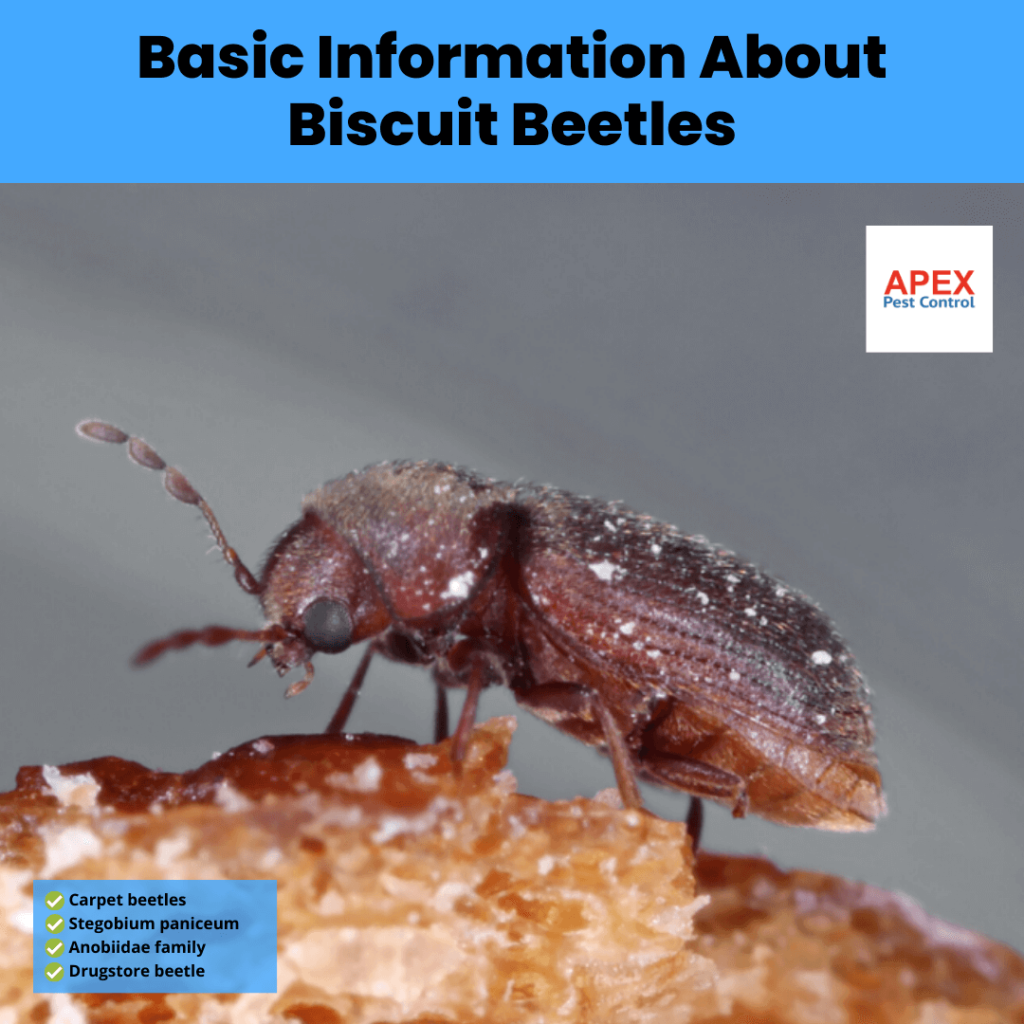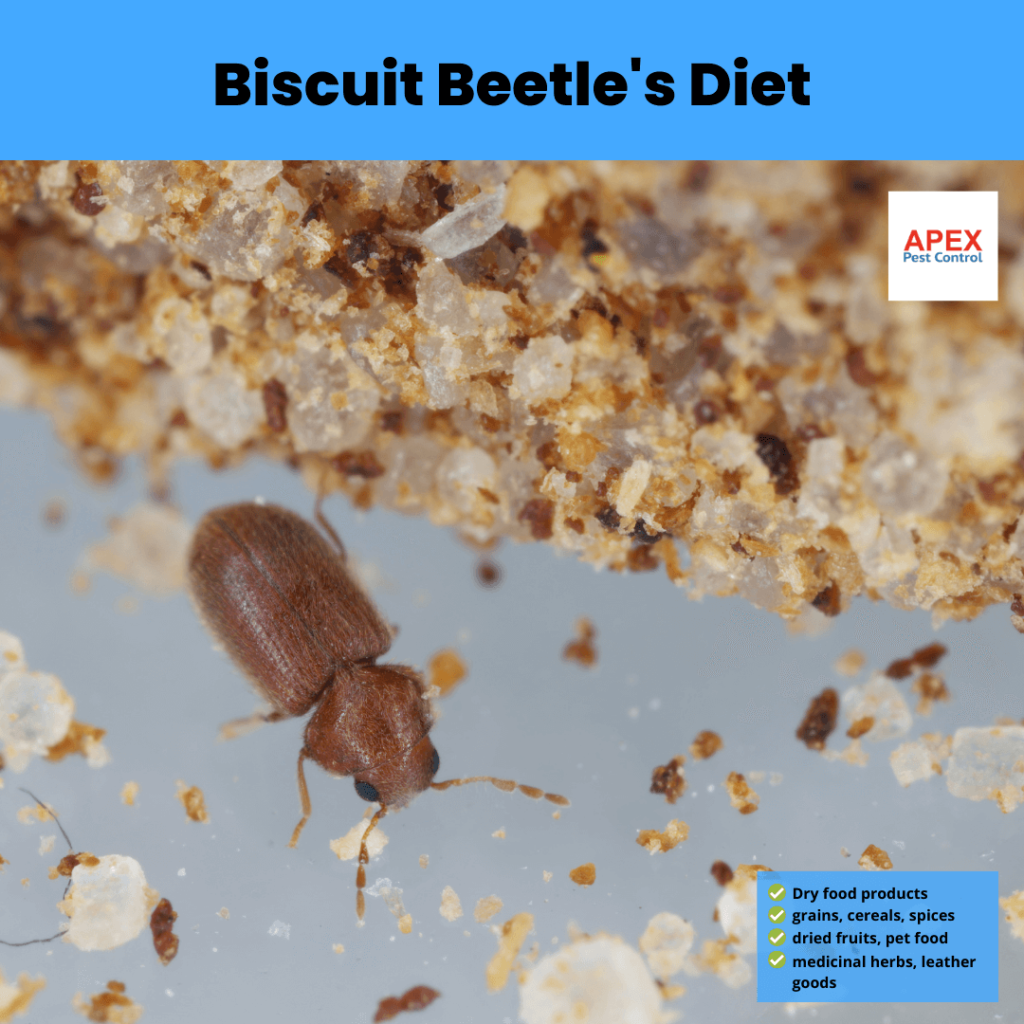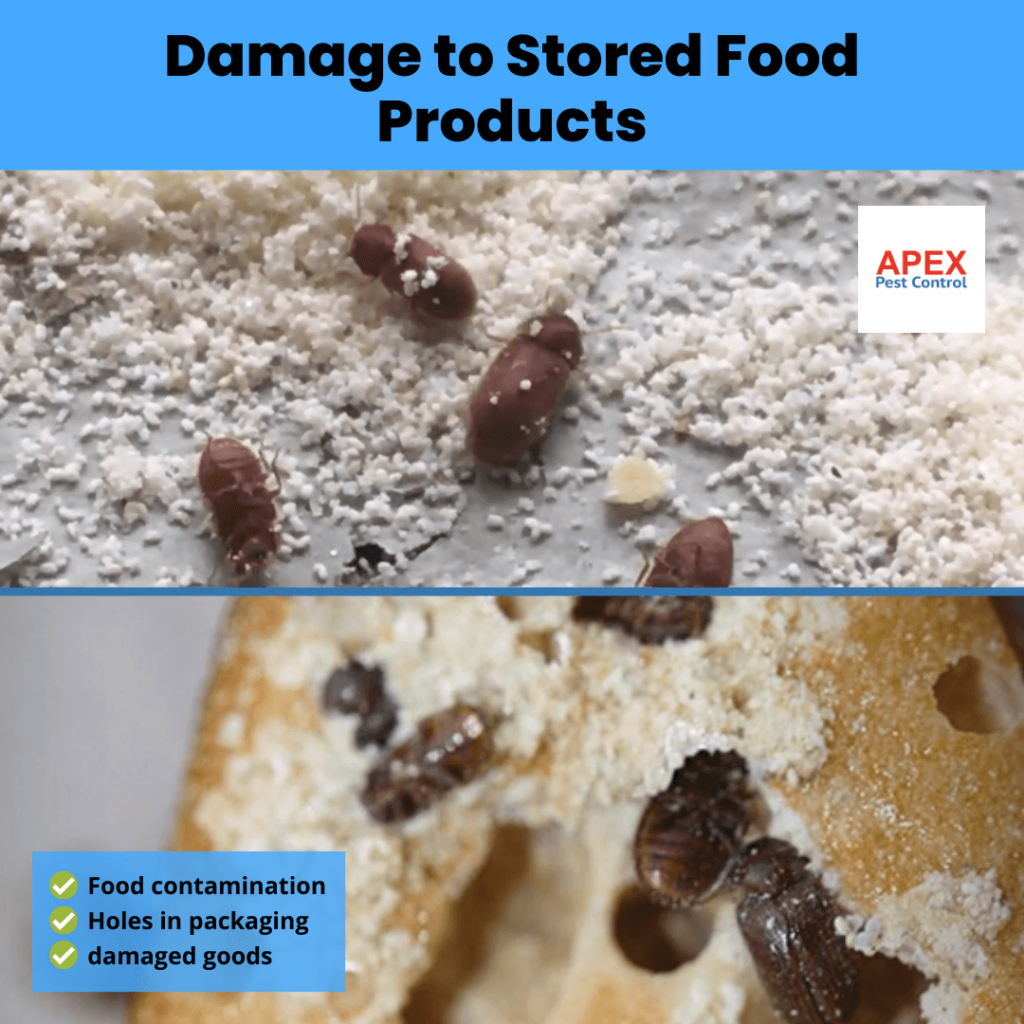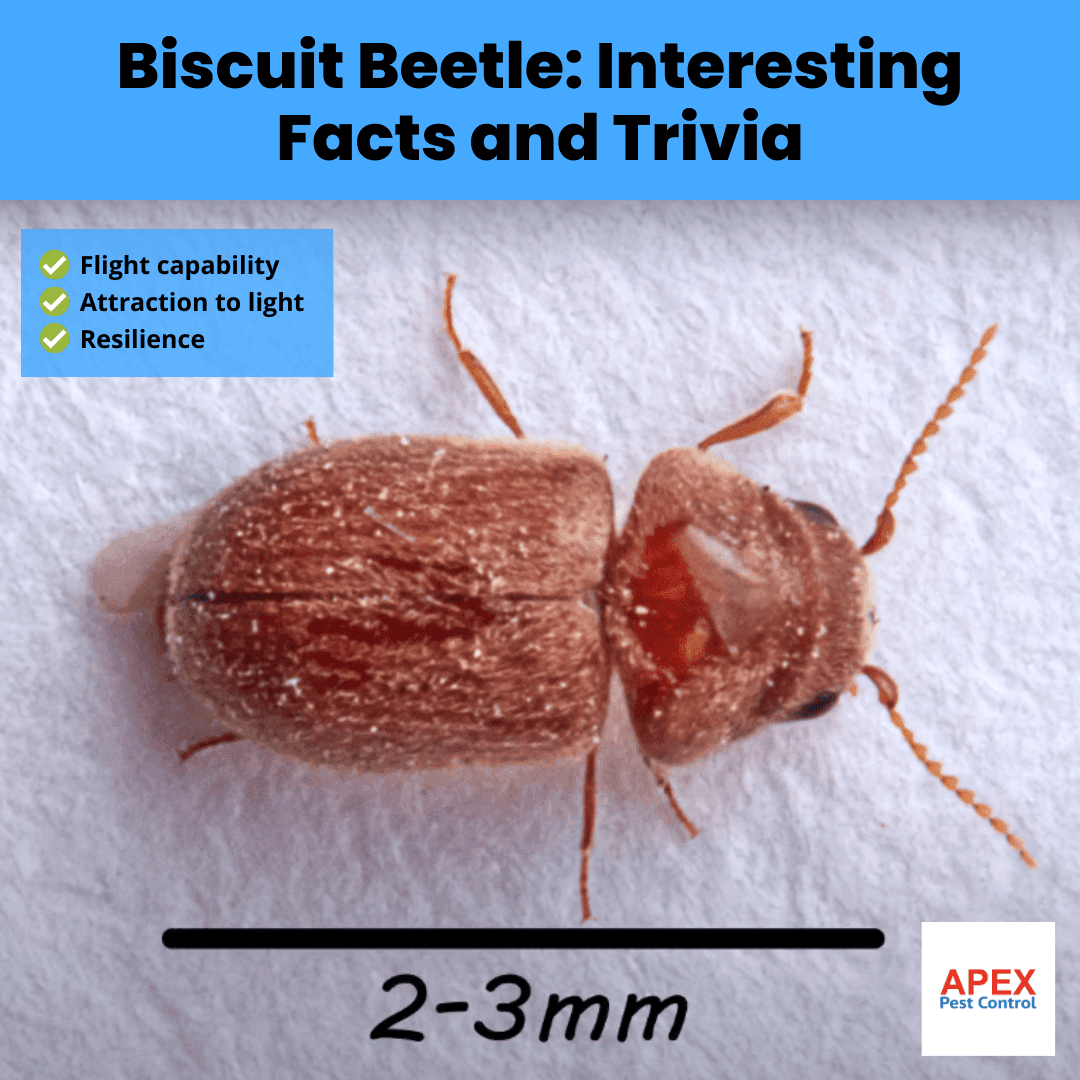The Intriguing World Of The Biscuit Beetle
Biscuit beetles, scientifically known as Stegobium paniceum, are small yet fascinating insects that often go unnoticed until they become a nuisance. These beetles, measuring about 2 to 3 millimetres in length, have a distinctive appearance with their reddish-brown colour and cylindrical shape.
Their tiny size allows them to infiltrate various food items and storage areas, making them a common pest in households and food production facilities.
Despite their pest status, biscuit beetles have unique biological and behavioural characteristics that make them an interesting subject of study.
Basic Information About Biscuit Beetles

Scientific Classification
The biscuit beetle, also known as the bread beetle or the drugstore beetle, is a common type of pest. Its scientific name is Stegobium paniceum and it belongs to the family Anobiidae. This beetle is closely related to other wood-boring beetles but has adapted to infest a wide variety of dry food products.
The fact that Stegobium paniceum is in the Anobiidae family shows how it evolved and how it eats, which are important details for understanding its behaviour and coming up with good ways to control it.
Physical Characteristics
Biscuit beetles are tiny creatures, typically measuring 2–3 mm in length. They have a brown colour and an oval-shaped body with wings under their hard shell. The adult beetle has a smooth and shiny appearance, with fine hairs covering its body. Their antennae are serrated, which distinguishes them from similar species.
The larvae are whitish, C-shaped, and covered in fine hairs, making them quite different in appearance from the adults. These physical characteristics are important for correctly identifying the beetle, especially during an infestation when both adults and larvae may be present.
Habitat and Distribution
These pests thrive globally but prefer warm climates. You can often find them in houses or stores where food is kept. They are particularly common in kitchens, pantries, and food storage areas, where they infest a variety of dry goods, including flour, cereals, spices, and dried herbs.
Biscuit beetles are highly adaptable and can survive in a range of environmental conditions, although they are most active and reproduce quickly in warmer temperatures.
Their widespread distribution and ability to infest diverse food products make them a persistent and challenging pest to control. Effective management requires a thorough understanding of their preferred habitats and behaviours.
Life Cycle of the Biscuit Beetle

Understanding their life cycle helps manage these pests better. The life cycle of the biscuit beetle consists of four main stages: egg, larva, pupa, and adult. Each stage plays a crucial role in the development and reproduction of these pests, making it essential to understand their life cycle to effectively manage infestations.
Egg Stage
A female biscuit beetle lays about 75 eggs at once, the white larvae of which hatch within two weeks. The eggs are typically laid in food sources or nearby areas where larvae will have immediate access to nourishment upon hatching. These eggs are tiny, making them difficult to detect with the naked eye.
Environmental elements like temperature and humidity can affect the incubation period for the eggs, with warmer conditions typically speeding up the process.
Larval Stage
Once hatched, the larvae seek food immediately. This stage lasts for up to four months, during which they moult several times before pupation begins. Larvae are voracious eaters and will burrow into food products, causing significant damage. Their diet includes a wide range of dry goods, from grains and cereals to spices and dried fruits.
As they consume food, they contaminate it with frass (insect droppings) and silk, which can render the products inedible.
The larval stage is the most destructive period in the life cycle of the biscuit beetle, emphasising the importance of early detection and control.
Pupal Stage
This stage, which lasts one to several weeks depending on factors like temperature and humidity, sees larvae changing into adult forms inside cocoons made of debris particles spun together using silk the larva itself produces.
The pupal stage is a period of significant change as the larva metamorphoses into an adult beetle. This stage is relatively immobile, making the tiny beetles vulnerable to environmental factors and predation.
The duration of the pupal stage can vary, but it is typically shorter in warmer, more humid conditions.
Adult Stage
Upon emerging from its cocoon after around seven days, an adult biscuit beetle starts looking for mates right away while feeding simultaneously; females start laying eggs just three days post-mating, resulting in more eggs and a rapid increase in population size.
Adult beetles have a relatively short lifespan, typically living for only a few weeks to a couple of months. During this time, they continue to feed and reproduce, perpetuating the cycle of infestation.
Effective pest management strategies must target all stages of the beetle’s life cycle to prevent and control future infestations.
Biscuit Beetle’s Diet

Bread isn’t all these beetles feed on! They love cereals too, along with spices and even dried fruits. The versatility of their diet makes them a common pest in both household pantries and commercial food storage facilities.
Beyond typical pantry staples like flour and pasta, biscuit beetles are known to infest a variety of dry food products. Their penchant for dried spices means they can often be found in spice racks, contaminating everything from paprika to black pepper.
Their diet also extends to dry pet foods, which can become infested if not stored properly. Additionally, they have been known to target medicinal herbs, dried flowers, and even leather goods. This wide-ranging diet not only makes them a persistent pest but also a costly one, as they can ruin large quantities of food and other stored products.
Moreover, biscuit beetles are particularly troublesome because they can chew through packaging materials such as cardboard, plastic, and even aluminium tin foil, to reach their food sources. This ability allows them to spread quickly through stored goods, making eradication difficult once an infestation takes hold.
Proper food storage and regular inspections are crucial to preventing and controlling infestations by these pervasive pests.
Preferred Food Sources
They are not picky eaters; everything from grain-packaged foods like flour to spices, including pepper, becomes part of their diet if it is available nearby. Biscuit beetles are known to infest a wide range of other dry foods and food items stored in homes, pantries, and stores. This includes pasta, nuts, dried beans, pet food, and even non-food items like dried flowers and tobacco.
Their broad dietary preferences make them versatile and resilient pests, capable of surviving in various environments as long as they have access to dry, starchy foods.
Feeding Habits
One thing noticeable about these beetles is how determined they seem when trying to reach any potential food source; they chew through plastic and even metal containers to get inside. This behaviour makes them particularly troublesome in both household and commercial settings. They can easily penetrate packaging materials, leading to widespread contamination of food supplies.
The beetles’ feeding habits not only cause direct damage to the food products but also result in contamination of the food material with their frass and shed skins, rendering the whole food source unfit for consumption.
The persistence of these beetles highlights the importance of proper food storage practises, and preventative measures such as using airtight containers and regularly inspecting stored foods for signs of infestation.
Impact of Biscuit Beetles on Humans

The impact of biscuit beetles on humans primarily revolves around the damage they inflict on stored food products. These pests can quickly infest pantry items such as flour, rice, cereals, spices, and dried fruits, rendering them unfit for consumption. As biscuit beetles feed on these food sources, they contaminate them with their faeces, cast skins, and secretions, posing a risk of foodborne illness if consumed unknowingly.
Additionally, biscuit beetle infestations can lead to financial losses for homeowners and businesses alike. Contaminated food products must be discarded, resulting in wasted resources and additional expenses to replace the affected items. In commercial settings such as grocery stores, warehouses, and food processing facilities, biscuit beetle infestations can tarnish reputations and result in regulatory fines or closures due to health code violations.
While biscuit beetles themselves are not known to transmit diseases directly to humans, the presence of these pests can still cause significant inconvenience and discomfort. Discovering an infestation in the pantry can be distressing for homeowners, leading to feelings of unease and frustration. Moreover, the persistence of biscuit beetle infestations can disrupt daily routines and require extensive efforts to eliminate them, impacting quality of life.
Damage to Stored Food Products

The severe damage biscuit beetles inflict on food in storage is one of their main problems. They consume, contaminate, and mine food residues and cause the destruction of such items. This can lead to significant economic losses, especially in commercial settings like grocery stores, warehouses, and food processing plants.
Infested products often have to be discarded entirely, resulting in waste and financial strain. Even in household settings, the discovery of an infestation can mean throwing away large quantities of food, which is both inconvenient and costly.
Health Risks
Although these pests do not pose any direct health risks, an infestation could result in contamination of food, leading to potential digestive problems if consumed unknowingly.
When biscuit beetles infest food items, they leave behind frass (insect droppings), shed skins, and possibly dead beetles, all of which can contaminate the food. Consuming contaminated food may lead to gastrointestinal discomfort or illness, particularly in individuals with compromised immune systems, children, and the elderly.
The presence of these pests can also trigger allergic reactions in some people, manifesting as skin rashes or respiratory issues. Maintaining strict hygiene and regular inspection routines is essential to mitigating these risks and ensuring food safety.
Biscuit Beetle Infestation

Biscuit beetles, also known as drugstore beetles, can cause significant problems when they infest homes, particularly in areas where food is stored. Understanding the signs of infestation and the common sites in affected areas where these beetles thrive is crucial for effective management and prevention.
Signs of Infestation
If you notice small holes in your food packaging or see tiny, small, reddish brown insects crawling around your pantry, it’s likely a sign that you have a biscuit beetle infestation. Other indicators include finding frass (insect droppings) near food packages, a musty smell in infested areas, or damaged goods with powdery residue. Regularly inspecting your food storage areas for these signs can help in early detection and prevent a minor pest problem from becoming a major infestation.
Common Infestation Sites
These bugs usually invade kitchen cupboards or pantries where dry goods are stored since these areas offer ample sources for sustenance. Biscuit beetles are particularly drawn to:
-
- Cereals and grains: Flour, rice, oats, and other grain-based products are prime targets.
- Spices and herbs: They can easily infest containers of dried spices and herbs.
- Dried fruits and nuts: These nutrient-rich items are also attractive to biscuit beetles.
- Pet food: Dry pet food is another common site of infestation due to its accessibility and nutritional content.
Ensuring that these items are stored in airtight containers can effectively eliminate the risk of infestation.
Prevention and Control of Biscuit Beetle Infestations

It’s important to control these pests as soon as possible because once they’ve established themselves in an area, it can be difficult to get rid of them completely without professional help!
Preventive Measures
Keeping homes clean, especially areas storing foods, along with regular inspections, should help prevent invasions by these pesky beetles. Avoid buying from stores known for pest issues too!
-
- Regular Cleaning: Keep your home clean, especially in areas where food is stored, such as pantries and kitchen cabinets. Regularly clean shelves, cabinets, and countertops to remove crumbs and spills that may attract biscuit beetles.
- Inspections: Conduct regular inspections of stored food items to check for signs of beetle activity, such as holes in packaging or the presence of beetles themselves. Discard any infested items promptly to prevent further spread.
- Purchase from Reputable Sources: Avoid purchasing food items from stores known to have pest issues, as this reduces the risk of introducing biscuit beetles into your home.
Control Methods
There are many ways, including traps laced with pheromones, to attract males, thereby disrupting their mating habits and eventually resulting in population reduction over time.
You can also use insecticides but only when absolutely necessary due to their potential harm to non-target organisms present within the same habitat.
-
- Pheromone Traps: Pheromone traps are an effective way to attract and trap male biscuit beetles, disrupting their mating habits and reducing the population over time.
- Insecticides: Insecticides can be used as a last resort to control biscuit beetle infestations, but they should be used judiciously and only when absolutely necessary. Care must be taken to choose insecticides that are safe for use in areas where food is stored and to follow application instructions carefully.
Professional Pest Control Services

When dealing with severe infestations, professional pest controllers with knowledge of a variety of techniques, including fumigation, are sometimes necessary to ensure complete eradication rather than just a reduction in numbers.
In cases of severe infestations or when DIY methods for getting rid of biscuit beetles are ineffective, seeking professional pest control services may be necessary. Apex Pest Control offers specialised services for managing biscuit beetle infestations. Their trained technicians have the expertise to assess the extent of the infestation and implement appropriate control measures, such as fumigation, to eradicate the beetles effectively.
By enlisting the help of professionals, homeowners can ensure thorough and comprehensive control of biscuit beetle infestations, restoring peace of mind and protecting their homes from further damage.
Biscuit Beetle: Interesting Facts and Trivia

Did you know that biscuit beetles can fly when temperatures are above 17 °C? It’s true! These tiny pests have wings and are capable of flight, especially in warmer weather. Additionally, biscuit beetles are attracted to light, which is why they are often found near windows and other sources of illumination. This behaviour makes them more noticeable and can contribute to their spread within homes.
Another interesting fact about biscuit beetles is their resilience. Despite their small size, these bugs can survive for up to eight days without food. This ability to withstand periods of starvation allows them to persist in various environments and contributes to their status as persistent pests.
Summary of Key Points about Biscuit Beetle
In summary, the biscuit beetle poses a significant threat to stored food products worldwide. Its ability to reproduce rapidly and infest a wide range of dry goods makes it a formidable pest in homes, grocery stores, and food processing facilities. The four distinct life stages of the biscuit beetle—egg, larval, pupal, and adult—contribute to its resilience and persistence in various environments.
Female biscuit beetles can lay hundreds of eggs during their lifetime, leading to exponential population growth if left unchecked. This reproductive capacity, combined with the beetle’s ability to fly and its attraction to light, presents challenges for effective pest control. Preventive measures such as maintaining cleanliness, storing food in airtight containers, and regular inspections are essential for managing biscuit beetle infestations.
It can be essential to hire a professional pest control company like Apex Pest Control in cases of severe infestation. Their expertise in identifying and treating biscuit beetle infestations can help homeowners and businesses eradicate these pests effectively.
By implementing a combination of preventive measures and targeted pest control service methods, individuals can protect their stored food products and maintain a pest-free environment.
Frequently Asked Questions
What do biscuit beetles eat?
They feed on grain products, including flour, besides spices such as pepper.
How long does it take for these beetles to mature?
Their lifecycle ranges from seven months to over a year, depending on environmental conditions like temperature and humidity.
Can I eliminate them myself or should I hire professionals?
While homeowners could manage minor infestations by themselves using tools like pheromone traps or insecticides, severe cases necessitate hiring professional pest controllers who use techniques like fumigation to ensure complete extermination rather than just partial reduction.
Where do biscuit beetles come from?
Biscuit beetles, also known as common furniture beetle and drugstore beetle, are commonly found worldwide. They often infest stored food products in homes, grocery stores, warehouses, and food processing facilities.
How can I prevent biscuit beetle infestations?
To prevent biscuit beetle infestations, it’s essential to maintain cleanliness in storage areas, store dry goods in airtight containers, and regularly inspect stored food for signs of beetle or damage. Avoid purchasing food items from stores with known pest issues.
Are biscuit beetles harmful to humans?
While biscuit beetles themselves are not harmful to humans, their presence can lead to contamination and spoilage of stored food products. Consuming infested food can potentially cause digestive issues, so it’s crucial to discard any items that show signs of beetle infestation.
What should I do if I discover biscuit beetles in my pantry?
If you discover biscuit beetles in your pantry, immediately remove and discard any infested food items. Thoroughly clean the pantry shelves and surrounding areas to remove any crumbs, spilled food or other substances that may attract beetles to fly in. Consider using traps and contacting professional pest control services for further assistance in eliminating the infestation.
How do biscuit beetles enter homes?
Biscuit beetles can enter homes through infested food products purchased from stores or through cracks and openings in walls food cupboards, windows, and doors. They are attracted to warm, dark, and moist environments, making pantries and kitchens ideal habitats for infestations. Regularly inspecting and sealing entry points can help prevent biscuit beetles from entering homes.
Remember, prevention always trumps cure – maintaining cleanliness coupled with regular inspections will keep these pests away from your home!

Tony Johnson, our pest control company founder, is your partner in pest management. With his extensive knowledge of Integrated Pest Mangement and commitment to staying updated on the latest Pest industry trends, Tony is a trusted source for effective pest control solutions. Your peace of mind is Tony’s top priority.
Trusted BPCA & NPTA member.


